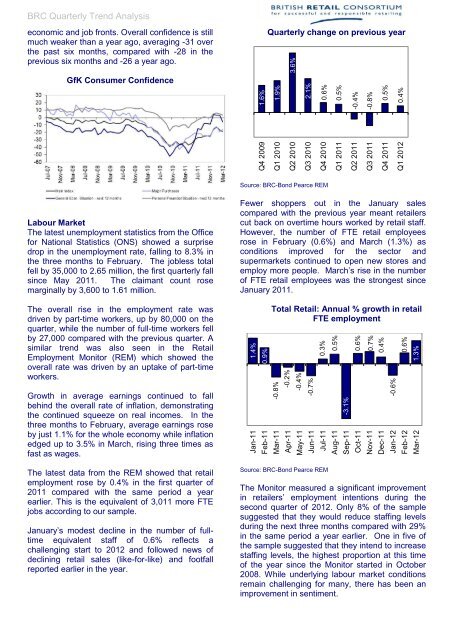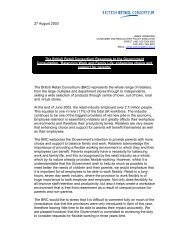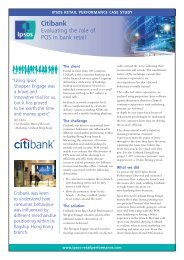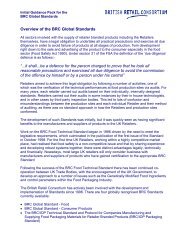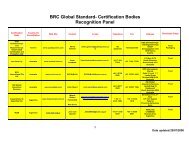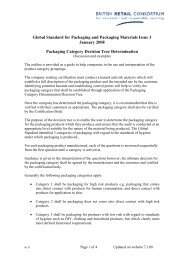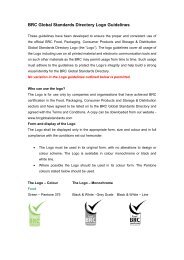BRC Quarterly Trend Analysis - British Retail Consortium
BRC Quarterly Trend Analysis - British Retail Consortium
BRC Quarterly Trend Analysis - British Retail Consortium
Create successful ePaper yourself
Turn your PDF publications into a flip-book with our unique Google optimized e-Paper software.
Jan-111.4%Q4 20091.6%Feb-110.9%Mar-11-0.8%Q1 20101.9%-0.2%Apr-11Q2 20103.6%-0.4%May-11Q3 20102.1%-0.7%Jun-110.3%Jul-11Q4 20100.6%Aug-110.5%Q1 20110.5%Sep-11-3.1%Q2 2011-0.4%Oct-110.6%Nov-11Q3 2011-0.8%0.7%Dec-110.4%Q4 20110.5%Jan-12-0.6%Q1 20120.4%Feb-120.6%Mar-12-1.3%<strong>BRC</strong> <strong>Quarterly</strong> <strong>Trend</strong> <strong>Analysis</strong>economic and job fronts. Overall confidence is stillmuch weaker than a year ago, averaging -31 overthe past six months, compared with -28 in theprevious six months and -26 a year ago.<strong>Quarterly</strong> change on previous yearGfK Consumer ConfidenceSource: <strong>BRC</strong>-Bond Pearce REMLabour MarketThe latest unemployment statistics from the Officefor National Statistics (ONS) showed a surprisedrop in the unemployment rate, falling to 8.3% inthe three months to February. The jobless totalfell by 35,000 to 2.65 million, the first quarterly fallsince May 2011. The claimant count rosemarginally by 3,600 to 1.61 million.Fewer shoppers out in the January salescompared with the previous year meant retailerscut back on overtime hours worked by retail staff.However, the number of FTE retail employeesrose in February (0.6%) and March (1.3%) asconditions improved for the sector andsupermarkets continued to open new stores andemploy more people. March’s rise in the numberof FTE retail employees was the strongest sinceJanuary 2011.The overall rise in the employment rate wasdriven by part-time workers, up by 80,000 on thequarter, while the number of full-time workers fellby 27,000 compared with the previous quarter. Asimilar trend was also seen in the <strong>Retail</strong>Employment Monitor (REM) which showed theoverall rate was driven by an uptake of part-timeworkers.Total <strong>Retail</strong>: Annual % growth in retailFTE employmentGrowth in average earnings continued to fallbehind the overall rate of inflation, demonstratingthe continued squeeze on real incomes. In thethree months to February, average earnings roseby just 1.1% for the whole economy while inflationedged up to 3.5% in March, rising three times asfast as wages.The latest data from the REM showed that retailemployment rose by 0.4% in the first quarter of2011 compared with the same period a yearearlier. This is the equivalent of 3,011 more FTEjobs according to our sample.January’s modest decline in the number of fulltimeequivalent staff of 0.6% reflects achallenging start to 2012 and followed news ofdeclining retail sales (like-for-like) and footfallreported earlier in the year.Source: <strong>BRC</strong>-Bond Pearce REMThe Monitor measured a significant improvementin retailers’ employment intentions during thesecond quarter of 2012. Only 8% of the samplesuggested that they would reduce staffing levelsduring the next three months compared with 29%in the same period a year earlier. One in five ofthe sample suggested that they intend to increasestaffing levels, the highest proportion at this timeof the year since the Monitor started in October2008. While underlying labour market conditionsremain challenging for many, there has been animprovement in sentiment.


